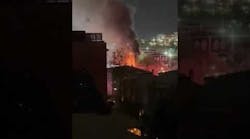On Sunday, Oct. 19, 2008, fire destroyed the International Fiber Corp. plant in North Tonawanda, NY. The company manufactures products to serve food, pharmaceutical, auto and industrial applications. Challenges facing firefighters included plant connections that were not compatible with fire department hose couplings and a delayed response by mutual aid companies. Also, open doors and long hallways allowed the fire to advance rapidly throughout the complex.
The 85,000-square-foot facility consisted of a group of interconnected buildings, with the oldest building being constructed in 1917. The main plant was constructed of Type II materials and the maintenance building was of ordinary construction. The roof of the main building was made of corrugated steel while the maintenance building roof was constructed of wood. One-third of the plant contained a sprinkler system. The sprinklers in this portion of the plant were operational, which limited the damage to the rear of this building.
At 6:37 A.M., the North Tonawanda Fire Department received a telephone call from an employee at the city water-pumping station that there was a fire in a building across the street on Archer Street. Engines 4 and 6, both 1,500-gpm pumpers; Ladder Truck 1, a 100-foot aerial ladder with a 1,500-gpm pump; Medium Rescue 1; and Command Car 10 responded with six firefighters under the command of Assistant Chief Christopher Fritz.
Upon arrival, Fritz found fire venting from the southeast corner of the facility, which was the maintenance shop, with light smoke showing from the roof-line eaves. Engine 4 laid a 100-foot, four-inch line from a hydrant next to the city pumping station to a position across from the fire building. The crew from Rescue 1 advanced a 1¾-inch attack line through a man door at the northwest corner of the two-story section of the building. A second 1¾-inch attack line was stretched as a backup line. A 2½-inch attack line was stretched to the south side of the building and used for exposure protection. Although the interior crews could not find the seat of the fire using a thermal imaging camera, hot spots were found overhead and firefighters used the attack line on those areas. After several minutes, fire was observed venting from the windows on the north side of the building near the roof. This was above and behind the interior attack team.
Fritz ordered firefighters to evacuate the building at 6:57 A.M., 18 minutes into operations. Truck 1 and Engine 6 were repositioned to the south side of the building. A 200-foot, four-inch line was laid from a hydrant at the end of Archer Street by Engine 6. Truck 1 was supplied with a 100-foot, four-inch line from Engine 6. Truck 1 placed two aerial master streams and two 2½-inch handlines into operation. The handlines were used to extinguish fire in truck trailers at the rear of the building.
Fritz requested a mutual aid truck and engine from the City of Tonawanda at 6:59 A.M. Due to another ongoing incident in the city and confusion with the County Dispatch Center, these units were not dispatched at this time. The fire continued to spread and was now seen extending past the Plant 6 Blender area toward the Detroit Street side of the building. The City of Tonawanda Fire Department was again requested at 7:15 A.M. to send an engine and a truck to the scene. Also, a request was made to Niagara County Fire Dispatch to send two engine companies from Niagara County for standby. Adams Fire Company Engine 1E1 and St. Johnsburg Fire Company Engine 20E1 responded and were then rerouted to the scene at 7:18 A.M. Shawnee Fire Company Engine 22E2 was requested to cover in for standby at North Tonawanda Fire Headquarters at 7:32 A.M.
Tonawanda Fire Department units were assigned to the Detroit Street side of the building. Tonawanda Ladder 1, a 100-foot aerial ladder with a 2,000-gpm pump, was set up for aerial master stream operations. This truck was supplied with a 300-foot, five-inch line and placed two master streams into operation. Tonawanda Engine 2, a 1,500-gpm pumper, was positioned behind Ladder 1 and was supplied with a 200-foot, five-inch line from a hydrant on Bridge Street. This engine supplied Ladder 1 with an additional five-inch line and firefighters also placed two 1¾-inch attack lines into operation from this engine. Tonawanda Engine 3, a 1,500-gpm pumper was positioned at the intersection of Detroit and Bridge Streets and placed two 2½-inch attack lines into operation to fight the fire in Warehouse 3.
St. Johnsburg Ladder 20A8, a 105-foot aerial ladder with a 1,750-gpm pump, was positioned south of Plants 2 and 3. St. Johnsburg Engine 20E1, a 1,750-gpm pumper, set up drafting operations at the Placid Harbor Marina and pumped a 1,000-foot, five-inch line to St. Johnsburg Ladder 20A8. Adams Engine 1E1 drafted from the Niagara River and supplied a 400-foot, five-inch line to North Tonawanda Engine 4. Additionally, deck guns were operated by North Tonawanda Engines 4 and 6. A portable master stream was placed into operation into Warehouse 3, supplied by two 2½-inch lines from Tonawanda Engine 3. Frontier Fire Company Engine 5E4 was dispatched to the scene for a relief crew for St. Johnsburg at 12:03 P.M.
With the continued use of aerial and ground master streams and handlines throughout the day, Fritz declared the fire under control at 5:23 P.M. Mutual aid companies continued to operate at the scene until the early-morning hours of Monday, Oct. 20, when they were released.
Approximately 100 career and volunteer firefighters operated eight engines and three ladder companies to bring the fire under control. One firefighter suffered minor injuries. Five aerial master streams, two deck guns, one portable master stream and numerous handlines were also used to extinguish the fire. Several million gallons of water was supplied from seven hydrants on the municipal water system and from two engines drafting from the Niagara River. Weather conditions were sunny with a temperature of 60 degrees at the time of the fire. The last North Tonawanda apparatus left the scene on Oct. 25.
A six-day on-site investigation was conducted by North Tonawanda fire investigators and the federal Bureau of Alcohol, Tobacco, Firearms and Explosives (ATF). The investigation continues at this time. Approximately 60,000 square feet of the facility was destroyed. Damage was estimated at over $2.5 million.
Among the lessons learned:
- Problems — The plant fire department connections were not compatible with the fire department hose couplings, making it impossible to pump into the sprinkler system. Mutual aid companies were delayed in responding due to another ongoing incident in the city causing confusing radio traffic.
- Successes — Calling for mutual aid early provided the resources needed to control the fire. Training with mutual aid departments allowed for seamless operations. Although several buildings were destroyed, five others in the complex were saved.
JAY K. BRADISH/IFPA, Firehouse® news editor, is a former captain in the Bradford Township, PA, Fire Department. He has been a volunteer firefighter and fire photographer for more than 25 years.





